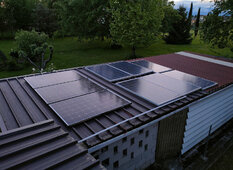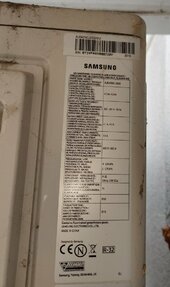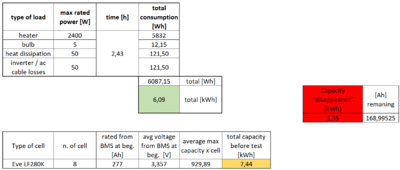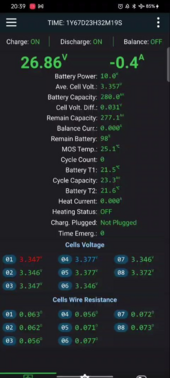perryfranz
New Member
Hi!
After 1 year of use my 24V battery with 8 LF280K + JK B2A8S20P has a strange behavior.
When i was using my AC split for heating it stopped working because the BMS has shuttled down for under voltage protection.
I thought because it has ended the capacity so i turned off the inverter and let the battery charge for the day.
After a few days the same behavior happened.
I tried to understand why and I thought it may be something wrong with the BMS.
Those were the data of my cells some days before all this happened when i let it charge fully to see if i have loose some capacity.
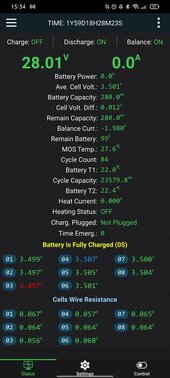
For me those are great value for an LFP cell (the MPPT was not charging anymore the battery and the BMS was balancing it).
3 days after the battery was shutting down looking at the data I thought that maybe it was some problem with the BMS.
 Keep an eye on cells n°2…
Keep an eye on cells n°2…
I let the battery charge for the morning and I have checked it. (I have no screenshot because I panicked)
The battery was fully charged after 4h (my system has 1200W of solar power, it’s impossible to charge 7kWh in 4h).
I reset the BMS pressing the lifepo4 button on the settings.
And after I have set the capacity the BMS showed me the real capacity of the battery:
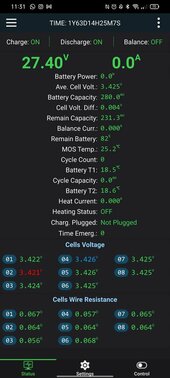
I thought that maybe the cells we’d unbalanced and I let him balance all the day and forget about it.
The day after the Same things happen but i was late for work and i only took some screenshot of the settings:
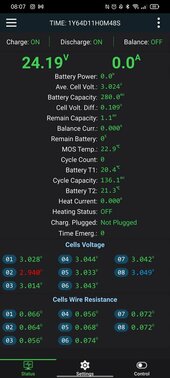

I reset the parameter again and went to work.
The day after same issue:
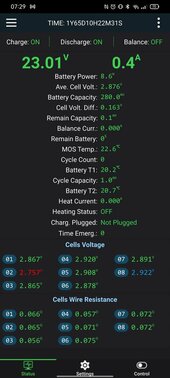 After reset the setting->
After reset the setting-> 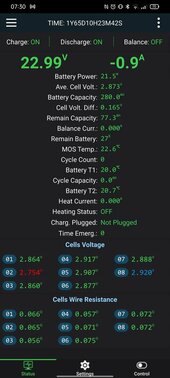
I tried to run some test with an heating element to see if the cell was dropping voltage during use or if there were other issue with the thermal camera:
the battery was at 78% with a average cell voltage of 3,39V (cell n°2 3,396V and cell n°5 3,401V). I tun on the heating element for 1290W and waited 10min (all the days before the AC unit was shutting down after 10 min of use).
Before turned on the element
turned on the element 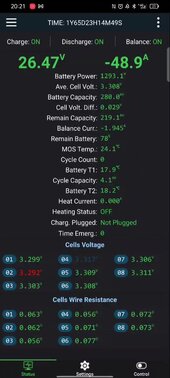 Turned on the second heating element
Turned on the second heating element 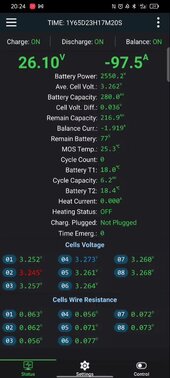
After a few minutes and then I turned off the heating element
and then I turned off the heating element 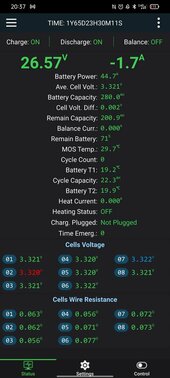 .
.
I’m not seeing some drastic voltage dropping, maybe the load was on not long enough (the AC unit do not use more than 800W in heating during spring in Italy).
During the test I have also took some pictures with the thermal camera but i do not see anything dramatic.
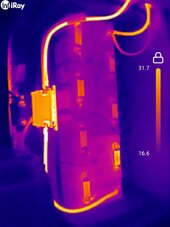

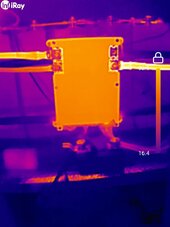 .
.
One busbar it seems to be hotter but is only reflecting heat due to a plastic shield i have applied to insulate a bit the busbar (maybe useless).
For your experiences it’s a cell fault or a BMS fault?
Do I have to run some other tests to understand better what’s going on?
I have also the YR1035 for the internal resistance and the DL24EW tester to run some capacity test.
After 1 year of use my 24V battery with 8 LF280K + JK B2A8S20P has a strange behavior.
When i was using my AC split for heating it stopped working because the BMS has shuttled down for under voltage protection.
I thought because it has ended the capacity so i turned off the inverter and let the battery charge for the day.
After a few days the same behavior happened.
I tried to understand why and I thought it may be something wrong with the BMS.
Those were the data of my cells some days before all this happened when i let it charge fully to see if i have loose some capacity.

For me those are great value for an LFP cell (the MPPT was not charging anymore the battery and the BMS was balancing it).
3 days after the battery was shutting down looking at the data I thought that maybe it was some problem with the BMS.
 Keep an eye on cells n°2…
Keep an eye on cells n°2…I let the battery charge for the morning and I have checked it. (I have no screenshot because I panicked)
The battery was fully charged after 4h (my system has 1200W of solar power, it’s impossible to charge 7kWh in 4h).
I reset the BMS pressing the lifepo4 button on the settings.
And after I have set the capacity the BMS showed me the real capacity of the battery:

I thought that maybe the cells we’d unbalanced and I let him balance all the day and forget about it.
The day after the Same things happen but i was late for work and i only took some screenshot of the settings:


I reset the parameter again and went to work.
The day after same issue:
 After reset the setting->
After reset the setting-> 
I tried to run some test with an heating element to see if the cell was dropping voltage during use or if there were other issue with the thermal camera:
the battery was at 78% with a average cell voltage of 3,39V (cell n°2 3,396V and cell n°5 3,401V). I tun on the heating element for 1290W and waited 10min (all the days before the AC unit was shutting down after 10 min of use).
Before
 turned on the element
turned on the element  Turned on the second heating element
Turned on the second heating element 
After a few minutes
 and then I turned off the heating element
and then I turned off the heating element  .
.I’m not seeing some drastic voltage dropping, maybe the load was on not long enough (the AC unit do not use more than 800W in heating during spring in Italy).
During the test I have also took some pictures with the thermal camera but i do not see anything dramatic.


 .
.One busbar it seems to be hotter but is only reflecting heat due to a plastic shield i have applied to insulate a bit the busbar (maybe useless).
For your experiences it’s a cell fault or a BMS fault?
Do I have to run some other tests to understand better what’s going on?
I have also the YR1035 for the internal resistance and the DL24EW tester to run some capacity test.



